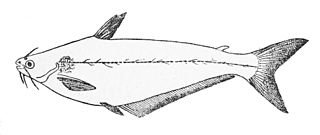 W
WThe African butter catfish is a species of fish in the family Schilbeidae. It is native to many major river systems in Africa. Other common names for the fish include butter fish, butter barbel, African glass catfish, lubangu, mystus catfish, silver barbel, and silver catfish. It was originally described as Silurus mystus by Carl Linnaeus in 1758.
 W
WThe bayad, is a species of bagrid catfish from Africa.
 W
WChiloglanis batesii is a species of upside-down catfish found widely in Western and Central Africa. This species grows to a length of 4.7 centimetres (1.9 in) TL.
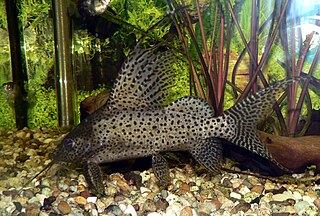 W
WThe featherfin squeaker or featherfin synodontis is a species of Synodontis catfish. This species is found in the basins of the White Nile, Volta and Niger Rivers and the Chad Basin. Also known simply as featherfin catfish. Featherfin squeakers are called such due to their ability to make noises to communicate with one another and also for their high feather-like fin which is valued by many hobbyists. Wild specimens can grow to a length of 30.0 centimetres (11.8 in) SL.
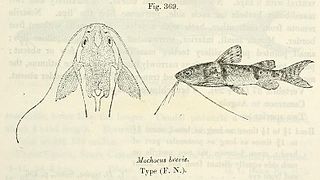 W
WMochokus brevis is a species of upside-down catfish native to the Nile and Chad Basins. This species grows to a length of 3.1 centimetres (1.2 in) TL.
 W
WThe Nile perch, also known as the African snook, Goliath perch, Giant lates or the Victoria perch, is a species of freshwater fish in family Latidae of order Perciformes. It is widespread throughout much of the Afrotropical realm, being native to the Congo, Nile, Senegal, Niger and Lake Chad, Volta, Lake Turkana, and other river basins. It also occurs in the brackish waters of Lake Maryut in Egypt. The Nile perch is a fish of substantial economic and food-security importance in East Africa. Originally described as Labrus niloticus, among the marine wrasses, the species has also been referred to as Centropomus niloticus. Common names include African snook, Victoria perch, and many local names in various African languages, such as the Luo name mbuta or mputa. In Tanzania, it is called sangara, sankara, or chenku. In Francophone African countries, it is known as capitaine. Its name in the Hausa language is giwan ruwa, meaning "water elephant".
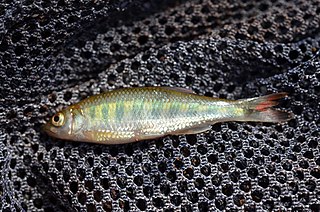 W
WRaiamas senegalensis is a species of cyprinid fish in the genus Raiamas from western Africa east to the River Nile. It sometimes is found in the aquarium trade.
 W
WSynodontis batensoda, the upsidedown catfish, is a species of mochokid upside-down catfish. It is unevenly distributed in inland waters across Africa from Senegal to Ethiopia, and is also known as a squeaker or giant upside-down catfish. It was originally described by Eduard Rüppell in 1832 in the paper "Continuation of the description and figure of several new fish, in the Nile. p1-14".
 W
WSynodontis clarias, known as the red tailed synodontis, or the mandi, is a species of upside-down catfish that occurs widely in the waters of northern Africa. It was first described by Swedish zoologist Carl Linnaeus in 1758 as Silurus clarias. The original specimens were obtained in Egypt, near Cairo. The meaning of the species name clarias is not certain, but may possibly have been used to mean "bright" or "clear".
 W
WSynodontis courteti is a species of upside-down catfish that is native to the countries of the Niger and Chad Basins. It has been recorded in Cameroon, Chad, Ghana, Guinea, Mali, Niger, and Nigeria. It was first described by French zoologist Jacques Pellegrin in 1906, from specimens collected in the Chari River, Chad. The species name courteti is named after M. Courtet, member of the "Mission Chari-Lac Chad".
 W
WSynodontis filamentosus, known as the longfin synodontis, is a species of upside-down catfish that is native to the basins of the Nile, Volta and Niger Rivers as well as the Chad Basin. It was first described by British-Belgian zoologist George Albert Boulenger in 1901, from specimens obtained near the mouth of Lake No, on the White Nile in Sudan. The species name filamentosus comes from the elongated rays of the dorsal and caudal fins.
 W
WSynodontis frontosus, known as the Sudan squeaker, is a species of upside-down catfish that is widely distributed throughout northern and central Africa. It has been reported in Chad, Democratic Republic of the Congo, Ethiopia, Kenya, Somalia, Sudan, and Uganda. It was first described by French zoologist Léon Vaillant in 1895, from specimens collected in the White Nile in Sudan. The species name frontosus is Latin, and means "broad head".
 W
WSynodontis membranaceus, known as the moustache catfish, is a species of upside-down catfish that is native to northern Africa. It was first described by French naturalist Geoffroy Saint-Hilaire in 1809 as Pimelodus membranaceus, from specimens obtained in the Nile River. The species name membranaceus refers to membranes present on the barbels of the fish.
 W
WSynodontis nigrita, known as the false upside down catfish, is a species of upside-down catfish that occurs widely in northern Africa. It was first described by French zoologist Achille Valenciennes in 1840. The type specimen is in the Muséum National d' Histoire Naturelle de Paris.
 W
WSynodontis ocellifer, known as the ocellated synodontis, is a species of upside-down catfish native to the rivers of northern and western Africa. It has been reported in 10 countries, including Burkina Faso, Cameroon, Chad, Gambia, Ghana, Guinea, Mali, Niger, Nigeria, and Senegal. It was first described by Belgian-British zoologist George Albert Boulenger in 1900, from specimens collected in Kunchow Creek, in Gambia. The species name ocellifer comes from the Latin word ocellus, meaning "eye", and the Latin word ifer, meaning "to carry", which refers to the black spots, possibly with white centers found on the sides.
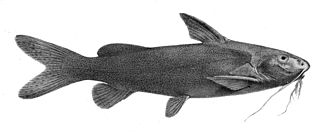 W
WSynodontis schall, the Wahrindi, is a species of upside-down catfish widespread in northern Africa. This species is in the largest genus of the family Mochokidae. This species grows to a length of 49.0 centimetres (19.3 in) TL.
 W
WSynodontis sorex is a species of upside-down catfish that is widely distributed in the rivers of northern Africa. It was first described by German zoologist Albert Günther in 1864, from specimens obtained in the upper Nile River, near Khartoum, Sudan. The species name sorex comes from the Latin word for shrew or shrew-mouse, the allusion was not explained. It possibly describes the pointed snout or the long, slender teeth.